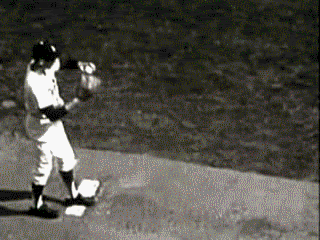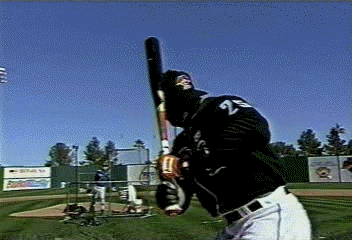quote:
Originally posted by BlueDog:
Mr. Tewks, IMO, you are misjudging when the front foot is down.....
Come on BlueDog. Does anybody else agree that I am misjudging when the front foot hits the ground. The clips are 30 fps, but I feel confident that high speed video would only further support what I've stated about the front foot being down.
quote:
Originally posted by BlueDog:
(1) When the back elbow moves is not the determinating factor.....The bat is turning in-between the hands when the back elbow is going down....(2) The bat is not moving forward....
(3) The back hip thrust at "go" is forcing the front foot down...
1. The back elbow moving isn't the determinig factor for WHAT? Please don't be cryptic and end sentences with "..." because I think this is a huge part of advanced hitting. But I also think you are picking clips that overexagerate your claims - like Berkman hitting from his power side in a homerun derby. In game situations, starting your hands before the front foot is down (as Berkman is doing) can cause tons trouble with off-speed pitching. (I don't think Berkman was worried about off-speed pitches in this clip.)
Just for fun, here's Berkman in the HR Derby at Yankee Stadium hitting from the left side. Maybe you'll disagree again, but what I see is very different from his right handed swing. If you want, I'll send you a link so you can download the video and make a GIF out of this clip.
Berkman Lefty HR Derby swing at 300 fps:
http://www.youtube.com/user/ab...#p/a/u/1/O4H-3I22iMs For his career, Berkman is a .310 hitter against right-handed pitching with a 1.024 OPS. Against left-handed pitching he's .266 and .792. (I know, I know, he gets more opportunities from the left side. But his swing is much better too.)
2. I'm not saying the bat is coming forward. I am saying that the hips are closed when the front foot is down. My explanation to powertoallfields in a previous post about hands/arm action was:
quote:
Originally posted by BobbyTewks:
"Arm/Hand Action - establish rhythm but stay soft, control the barrel with your hands (not your arms), the back elbow dropping/slotting can't cause the barrel to drop when initiating the swing, stay inside the ball"
The Pujols clip is a perfect example (from a game too!) of the back elbow dropping without the change in bat angle. You frequently use the phrase "all great hitters" when speaking of your absolutes. How much the elbow slots is a product of where the elbow starts. Pujols is great and starts his elbow pretty high. Justin Morneau is pretty good too (great when healthy?), and he starts his elbow much lower than Pujols. Here's a HR Derby clip at 300 fps:
http://www.youtube.com/user/ab...#p/a/u/0/JBAnu1GCwEc This is one of the biggest issues I see with high school swings. When the back elbow dropping causes the barrel to drop, the swing gets "loopy" and long. Problems linked to this issue include (but are certainly not limited to) staying "connected", swing direction/path, matching the plane of the pitch, staying inside the ball, timing. For adjusting to pitches, this is all extremely detrimental.
3. Their is certainly a relationship between the back hip "thrust" and the front heel moving down. What I consistently see is that the front heal moving down is also linked up with the back knee and hip driving and with a start of the swing with the hands/back elbow. (Again, elbow height has a lot to do with what is moving to start the swing.) As proven by your Berkman clip, the front foot does not need to be down for this process to start - but would usually cause a lot of trouble if you aren't getting a fastball middle-in.
And just for fun, Josh Hamilton at 600 fps from the HR Derby as well. (Yeah, I know. He's got a little "flying open" going on too. What a show!)
http://www.youtube.com/user/ab...#p/a/u/1/nw4cy58WZns







